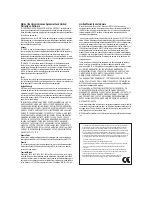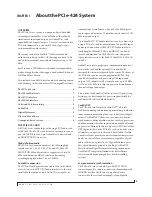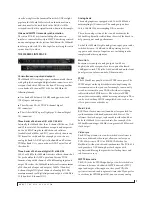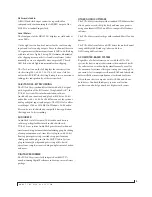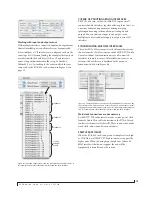
A B O U T T H E P C I E - 4 2 4 S Y S T E M
7
transfer a single track of material from the ADAT via light
pipe into the 2408mk3’s Macintosh workstation software,
and then transfer the track back to the ADAT, it will be
recorded exactly at its original location, down to the sample.
Video and SMPTE time code synchronization
The entire PCIe-424 system, including all connected
interfaces, can resolve directly to SMPTE time being received
on any analog input in the system. In addition, the 2408mk3
interface provides a BNC video input for resolving the entire
system directly to video.
THE 2408MK3 INTERFACE
24 simultaneous inputs and outputs
The 2408mk3 I/O is a single-space, rack mountable chassis
with gold-plated analog and digital audio connectors on its
rear panel and status LEDs on the front. The rear panel has
seven banks of 8-channel I/O at 44.1 or 48 kHz in the
following formats:
■
One bank of 8 balanced (+4 dB) analog quarter-inch
(TRS) inputs and outputs.
■
Three Tascam DA-88 ‘TDIF’ 8-channel digital
I/O connectors.
■
Three Alesis ADAT optical ‘light pipe’ 8-channel digital
I/O connectors.
Three banks of 8-channel I/O at 44.1/48 kHz
Internally, the 2408mk3 has three 8-channel I/O busses (A, B
and C) for a total of 24 simultaneous inputs and outputs at
44.1 or 48 kHz. Using the included console software
(available for both Mac and PC), you can freely choose any
I/O format for each bank. For example, you can choose
analog for Bank A, ADAT optical for Bank B, and Tascam
TDIF for Bank C. Or you can choose ADAT optical for all
three banks.
Three banks of 4-channel digital I/O at 88.2/96
At 88.2 or 96 kHz, the 2408mk3 interface offers 4 channels of
I/O per bank for the ADAT optical and Tascam TDIF
formats, along with 8 channels of 96 kHz analog input and
output. Therefore, the 2408mk3 interface offers a maximum
of 16 channels of input and output at 96 kHz (2 banks of
4-channel digital I/O plus 8 channels of analog I/O). The
maximum number of digital inputs and outputs at 96 kHz is
12 (3 banks of 4-channel I/O).
Analog bank
The analog inputs are equipped with 24-bit, 96 kHz 64x
oversampling A/D converters. The analog outputs have
24-bit, 96 kHz 128x oversampling D/A converters.
The entire analog section of the circuit board inside the
2408mk3 is physically isolated from the rest of the board to
help ensure quiet analog performance.
Each of the 2408mk3’s eight analog stereo input pairs can be
switched between -10 dB and +4 dB operating levels to
support a wide variety of input sources, including synths,
samplers and other equipment.
Main Outs
For main stereo output, analog outputs 1 and 2 are
duplicated on the rear panel as a stereo pair of balanced,
+4dB quarter-inch TRS jacks. A dedicated knob on the front
panel gives you volume control of the main outs.
SPDIF
The 2408mk3 rear panel has three SPDIF stereo pairs. The
SPDIF output on the right is dedicated to duplicating the
stereo main out so that you can, for example, conveniently
record a stereo mix to your DAT deck without swapping
cables with other SPDIF devices. The other two SPDIF
connectors serve as independent stereo inputs/outputs. They
can be used with any SPDIF compatible device, such as an
effects processor or other device.
Word Clock
BNC Word clock connectors (in and out) are provided for
synchronization with standard word clock devices. Via
software, the word output can be made to either double or
halve the 2408mk3’s system word rate. For example, if the
2408mk3 is running at 96 kHz, it can generate 48 kHz word
clock output.
Video sync
The BNC input connector can be switched via software to
become a dedicated video input, allow you to slave your
PCIe-424 system to NTSC or PAL/SECAM video (or
blackburst) without a dedicated synchronizer. The PCIe-424
card provides a DSP-driven phase-lock engine with
sophisticated filtering that provides fast lockup times and
sub-frame accuracy.
SMPTE time code
The RCA jacks for SPDIF input/output can be switched via
software to become a dedicated SMPTE time code (LTC)
input and output, allowing you to slave your PCIe-424
system to time code and/or generate time code. If you prefer
to use them for SPDIF digital I/O, you can use any analog




